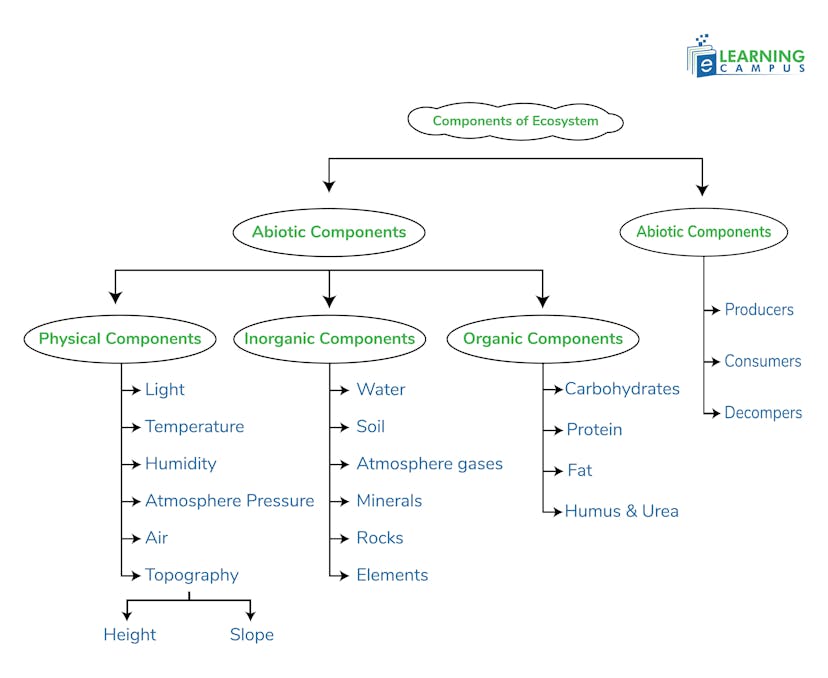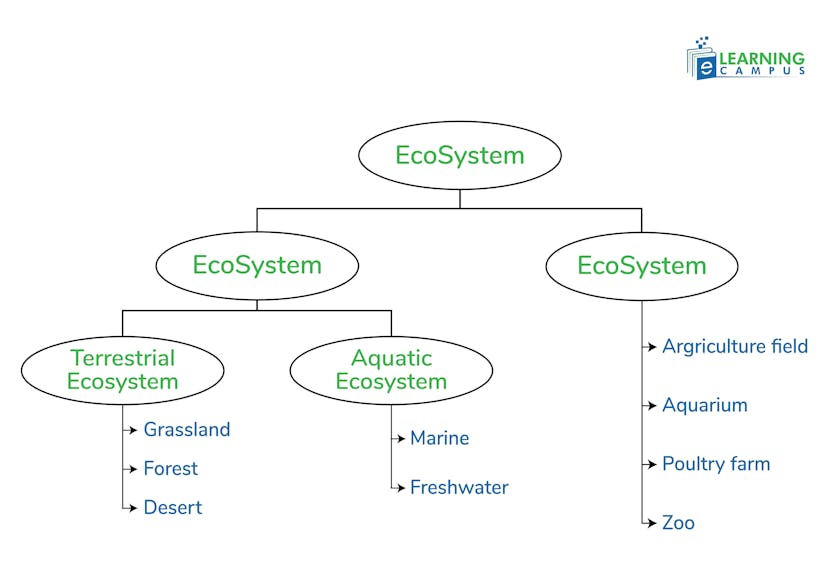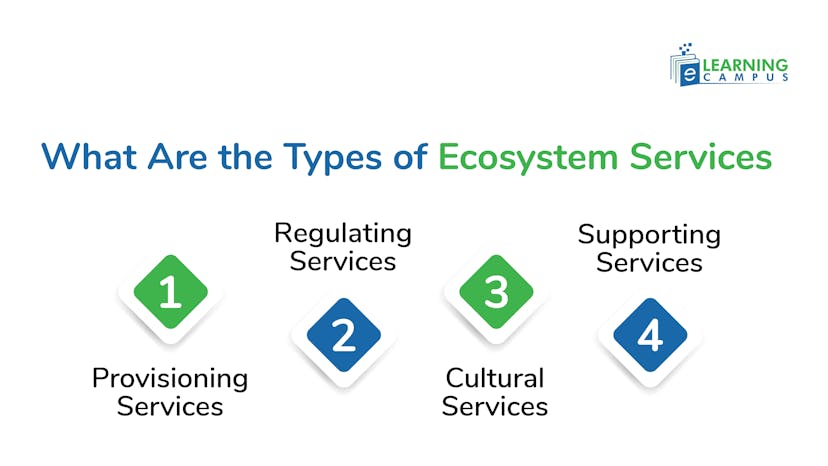Ecosystem and Ecosystem Services | Green Climate & Biodiversity

Have you ever thought that all the components around us have a role in our survival? All living and nonliving things make a chain of interaction, making survival possible.
An ecosystem is the system of interaction of living organisms within a community. Ecosystem services are the benefits that humans derive from ecosystems.
What is an Ecosystem
An ecosystem is the interconnected web of living organisms, such as plants, animals, microorganisms, and their physical environment. The ecosystem comprises both living and nonliving components of a community.
What are the Components of an Ecosystem
An ecosystem consists of two main components, biotic and abiotic. These two components depend on and interact with each other for survival.
Biotic Components of Ecosystem
All the living organisms of an ecosystem are the biotic component. It includes plants, animals, and microorganisms like bacteria and fungi.
The biotic components of the ecosystem are further divided into three categories.
- Producers: These are organisms that create their own food through photosynthesis, using sunlight and water. These include plants.
- Consumers: These are organisms that depend on other organisms for food and energy by consuming them. Consumers can be herbivores (plant-eaters), carnivores (meat-eaters), or omnivores (plant and meat eaters).
- Decomposers: These organisms break down dead plants and animals. For example, bacteria and fungi.
Abiotic Component of Ecosystem
Abiotic components of an ecosystem are the non-living and physical factors of the environment on which living organisms depend for survival.
An abiotic component of an ecosystem has three main categories.
- Physical Components: These include temperature, sunlight, air, and soil.
- Inorganic Components: These involve inorganic substances like minerals and nutrients.
- Organic Components: These components include carbohydrates, proteins, fats, etc.

What are the Types of Ecosystems
There are two main types of ecosystems, namely natural ecosystems and artificial ecosystems. A natural ecosystem exists without human intervention, while the artificial system same into existence due to human activities.
Natural Ecosystem
A natural ecosystem interconnected community of living organisms that interact with their nonliving environment. It is a self-sustaining community that develops and functions without significant human interference.
The natural ecosystem is categorized into two types, i.e, the Terrestrial ecosystem and the Aquatic ecosystem.
Terrestrial Ecosystem
The terrestrial ecosystem is a land-based community of living organisms and their interaction with the environment. The terrestrial ecosystem includes;
- Forest ecosystem: A forest is a large area dominated by trees and vegetation. The forest ecosystem is the most diverse ecosystem of plants and animals. They offer diverse habitats to a wide range of species.
- Grassland ecosystem: The area dominated by grasses is the grassland. This ecosystem is a feature of cold regions. It supports grazing animals.
- Desert ecosystem: A desert ecosystem is a dry environment with scarce vegetation, low rainfall, and extreme temperatures. It supports unique plants and animals adapted to survive with minimal water.
- Tundra ecosystem: Cold, treeless regions with permafrost, supporting unique plant and animal communities.
Aquatic Ecosystem
An aquatic ecosystem is a marine-based community of living organisms that interact with each other and their water environment. These ecosystems include diverse habitats, such as oceans, lakes, rivers, and wetlands.
The aquatic ecosystem is further divided into two categories.
- Marine Ecosystem: The Marine ecosystem is the aquatic ecosystem that exists in water with a high quantity of salt. It includes open oceans, deep-sea trenches, salt marshes, and rocky shores.
- Freshwater Ecosystem: It is an ecosystem that exists in fresh water or the aquatic environment with the lowest concentration of salt, which is less than 1%. It is found in lakes, rivers, streams, and wetlands.

Artificial Ecosystem
An artificial ecosystem is a human-modified environment in which ecosystem components interact for survival. It is obtained by changing certain aspects of natural ecosystems for specific purposes, such as agriculture or recreation.
The artificial ecosystems are not self-sustaining and require human intervention for survival and existence.
The artificial ecosystem includes;
- Agricultural fields
- Aquariums and Fish Farms
- Zoos and Botanical Gardens
- Greenhouses
- Managed Forests
- Dams and Reservoirs
What are Ecosystem Services
Ecosystem services are the benefits and services that humans get from natural ecosystems. It is also known as nature’s benefits. The ecosystem services and benefits can be tangible or less tangible. In either case, they offer several benefits for human beings.
What Are the Types of Ecosystem Services
There are 4 types of ecosystem services. These types of ecological services are categorized based on how humans benefit from the natural ecosystem. The four categories of ecosystem services are provisioning, regulating, cultural, and supporting services.

Provisioning Services
The provisioning services of ecosystems are the tangible products that natural ecosystems provide for human beings. These services include food, such as crops, fish, livestock, water, timber, fuel, and several medicinal resources.
Regulating Services
Regulating services are the benefits humans obtain from the regulation of ecosystem processes. These ecosystem services include air and water purification, climate regulation, pollination, waste decomposition, flood control, and disease regulation.
Cultural Services
The cultural services of ecosystems are the non-material benefits that humans gain from natural ecosystems. These include recreational opportunities, aesthetic enjoyment, spiritual and cultural experiences, and educational and scientific opportunities.
Supporting Services
These are the basic ecological processes that support the production of all other ecosystem services. The supporting ecosystem services include the water cycle, nutrient cycling, soil formation, and photosynthesis.
The supporting services of the ecosystem are essential for the existence of all other services.
What is the Relationship Between Ecosystem and Ecosystem Services
Ecosystems and ecosystem services are naturally linked phenomena. Ecosystems are the source of ecosystem services that humans and other living organisms use.
- Ecosystems are the source of ecosystem services.
- The health and integrity of an ecosystem directly influence the quantity and quality of the services it provides.
- Changes in ecosystems can negatively impact the provision of ecosystem services.
Conclusion
Ecosystems are dynamic communities of living organisms interacting with their non-living environment, providing humans with a wide range of benefits and ecosystem services. The ecosystem provides all the elements necessary for living and survival of the living organisms.
Learn Science online
Are you struggling with science? Don’t worry. We can help you. We have expert online science tutors to make you confident in science subjects. Whether you are preparing for exams or doing your homework, our tutors help you in every aspect.
